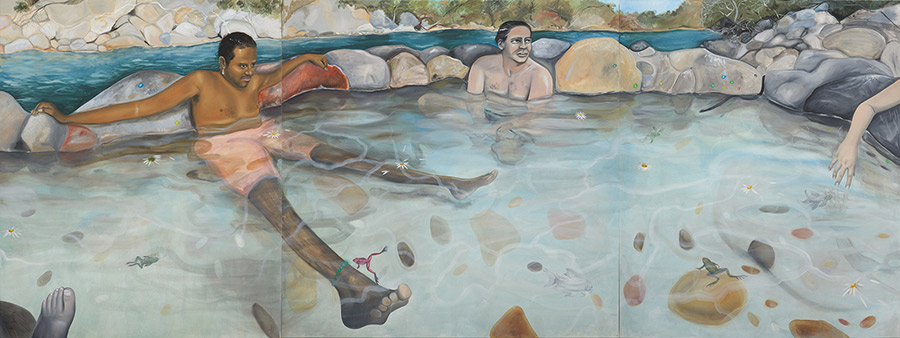
Remington Hot Springs, a painting by Katja Seib, whose work was on view in August at Sadie Coles HQ, London © The artist. Courtesy Sadie Coles HQ, London
Atmospheric warming is shrinking the diurnal temperature range, the septic systems of Nags Head are failing as sea levels rise, and PFAS are damaging the immune systems of Cape Fear alligators. Reduced flow from the Colorado River is causing the Salton Sea to dry into toxic dust. Microbes on Mars may have degraded the planet’s atmosphere by overproducing greenhouse gases. The Late Miocene Cooling Event, previously attributed to carbon dioxide drawdown from Himalayan silicate weathering, may have been caused in large part by ash from Andean volcanism. Small-scale tests are under way to model the installation of a 169-mile-wide seaweed farm in the South Atlantic Gyre, and scientists were hopeful that metal-organic frameworks will allow targeted carbon dioxide removal from the atmosphere and may aid human colonization of other planets. 3D printed bricks of lunar regolith were deemed potentially viable for construction on the moon. Precession was observed for the first time among a pair of binary black holes. Tree ring records indicate that a Miyake Event has about a 1 percent chance of occurring in the next decade, though it is unclear whether it would destroy human civilization. Climate change may make it difficult for Shias to commemorate the martyrdom of Ali but will increase opportunities for seeing rainbows.
The Journal of Moral Education found that adults prefer children’s diplomatic lies to their blunt honesty. A survey of eighteen countries found that children who play around rivers, lakes, and seas have better mental health as adults. Newborns who have suffered left-hemisphere strokes shift sentence processing to the right hemisphere. Previously deployed U.S. service members retain the dust of the Afghan and Iraqi deserts. Targeted memory reactivation with the C69 piano chord reduces the incidence of non-traumatic nightmares and increases the joyousness of dreams. Three hundred and eight years after they were first observed, phantom violin notes were proven to be real, and can be produced more powerfully by superior violins. Injecting healthy genes into the eyes of adults with a form of congenital blindness restored their night vision. A team from the Institute of Transformative Bio-Molecules discovered the pheromone that makes grass puffer fish spawn on beaches under the moonlight. Hypoactive sexual desire in women may be mitigated by kisspeptin. Researchers cautioned that the “apparently more liberated sexual behavior” reported by redheaded women “could be the consequence of potential mates’ frequent attempts to have sex with them.” Erect-crested penguins reject their first eggs. Migratory birds lured by light pollution are then poisoned by air pollution.
Britons, among whom non-padded coats have the longest consumer lifespan of any garment, are dying faster than expected. A switch to year-round daylight saving time would result in 36,550 fewer U.S. deer deaths each year. Colorado scientists who x-rayed eleven swarms of bees discovered complex and beneficial clustering patterns, and a Massachusetts woman was arrested for wielding a swarm of bees to attack police officers on Memery Lane. Eastern fence lizards may improve their resistance to fire ant stings by eating fire ants. The horns of all five species of rhino have been getting smaller over the past century. When an aye-aye picks its nose, its finger travels through the sinus, into the throat, and into the mouth. “It was like—where is it going?” said the researcher of the behavior. “Is it inserting it into its brain?” Mice do not vomit, but they do retch. Blue fibers found amid the dental calculus of sacrificial victims in a Belizean cave may have been Mayan death gags.




